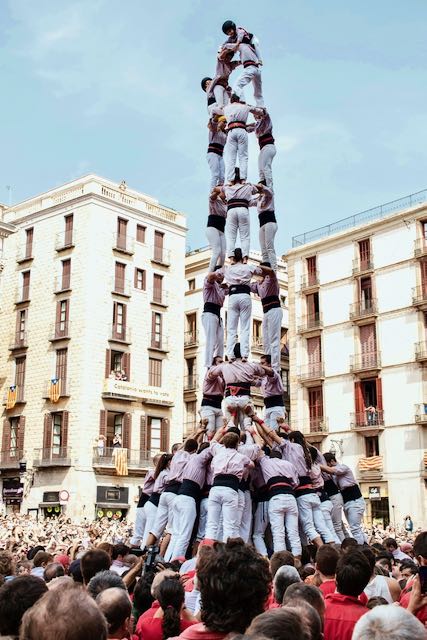
(Image courtesy of Angela Compagnone)
When I first witnessed the Catalan Towers, I was struck not only by their innovative courage and spirit, but that that spirit embodies the qualities we will need to survive and prosper.
The Catalan castells, or human towers, are one of the most breathtaking expressions of teamwork and interdependence found anywhere in the world. Originating in Catalonia, Spain, castells involve groups of people, known as colles, building tall, intricate towers made entirely of human beings, with the youngest and smallest children climbing to the top. This unique tradition, designated by UNESCO as part of the Intangible Cultural Heritage of Humanity, embodies a spirit of unity and collaboration that goes beyond mere spectacle—it speaks to the very essence of human connection, resilience, and our interdependent future.
Castells have their roots in the 18th century in the town of Valls, near Tarragona. They likely evolved from earlier folk dances that included moments of human stacking. Over time, these towers became a central part of Catalan culture, transforming from simple structures into impressive, multi-level towers that require skill, courage, and, most importantly, collective effort. As the tradition spread, different towns formed their own colles, creating a supportive yet competitive culture where groups push each other to reach greater heights, literally and figuratively. Today, castells range from 6- to 10-tiers high and are supported by extensive practice, precision, and a deeply ingrained respect for each member’s role within the tower.
The creation of a castell is a powerful metaphor for interdependence. The base, called the pinya, is made up of a large group of people who create a solid foundation, dispersing weight and ensuring stability. As levels are added, smaller and more agile members climb to form each successive tier. At the very top, a child known as the enxaneta raises one hand, signaling the castell’s completion. Each individual, from the strongest adult at the bottom to the lightest child at the top, has a crucial role. Without every person’s full commitment, the tower could not stand. Castells teach us that everyone, regardless of age or size, has something valuable to contribute to the greater whole.
One of the most profound lessons of castells is the strength found in unity. Building a human tower requires precise coordination, unwavering trust, and shared purpose. Each member relies on the others not only for support but also for encouragement and motivation. This trust is not just a matter of emotional support but a literal lifeline for those at higher levels, whose balance and safety depend on the stability and commitment of those below. Castells remind us that when we come together, we can build extraordinary things that reach heights impossible to achieve alone.
Beyond teamwork and unity, castells carry a message of resilience and endurance. Collapsing towers are a common occurrence in this tradition, and while the colles take every precaution to minimize injuries, falls happen. But the lesson here is in the recovery; even after a tower collapses, the group comes together, assesses what went wrong, and tries again. This relentless determination exemplifies the spirit of resilience and reminds us that setbacks are temporary when met with collective effort and perseverance.
Can you see why I might suggest that Castells are also a beautiful symbol of the future of humanity. The presence of children at the very top of the towers symbolizes hope, progress, and the continuation of traditions that connect generations. The younger members are supported by the strength, knowledge, and experience of older generations below them, illustrating how each generation builds on the foundation of those who came before. This intergenerational aspect of castells mirrors society’s need to invest in and support younger generations, trusting them to reach new heights.
What makes castells so awe-inspiring is not just their height or complexity, but the humanity they represent. They showcase what can be achieved when people come together with trust, respect, and a shared goal. Castells remind us that our strength as humans lies in our capacity to work together, to lift one another up, and to reach for the sky while firmly grounded in unity — cooperating, collaborating, and communicating to foster creativity. This Catalan tradition, rooted in centuries of community and collaboration, serves as a powerful reminder of what we can achieve when we support one another—whether we are building human towers or striving for progress on a global scale.
Bob Fagan has just published “The Little Book of Questions That Matter — A Lifetime Companion For Transforming Your Life.” It is available on Amazon. Through 2025, all proceeds will be donated to charity.
